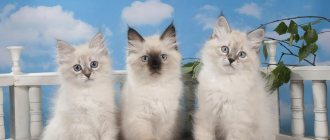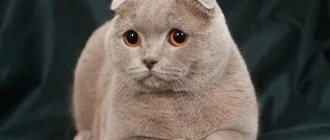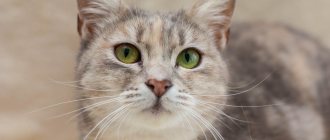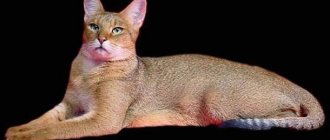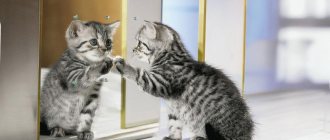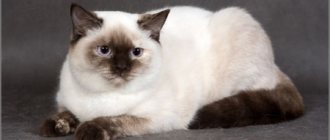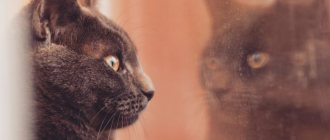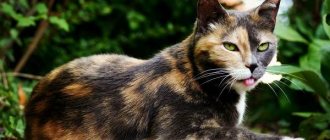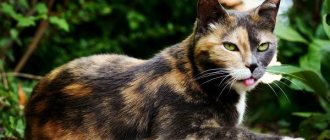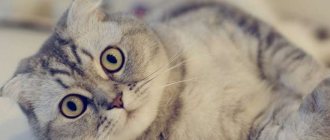What does the Blue Point color mean?
An unusual coloring called Color Point has long been characteristic only of the Siamese breed. Its main difference is the presence of color only in certain places, the so-called points.
The shade appears only on the tail, ears, paws and nose, the rest of the cat’s body remains white.
At birth, babies are completely white, and only then the tail gradually darkens, then the ears, and lastly the paws become colored and a mask appears on the face.
How is it formed and what are the distinctive features of such an unusual color?
The color point cat breed is no longer some kind of exotic. Every year such pets are becoming increasingly popular. But they still have certain features:
- Color point kittens are always born only in light shades. Only after a few days do the first pigment spots begin to appear on the paws, tail, and then on the face. This is due to the fact that during intrauterine development the kittens were exposed to constant warm temperatures. After birth and exposure to a colder environment, the coloring pigment begins to activate, which entails darkening of certain areas of the body.
- The appearance of a point kitten can only be guaranteed if both of its parents also have a pigmented color. But sometimes there are exceptions. One or even both parents can have a solid coat, but be carriers of the cs gene, which is responsible for darkening the peripheral areas of the body. In this case, some kittens will turn out to be pointing.
- The intensity of the color difference depends on the temperature in which the animal is located. The lower it is, the darker and richer the pigment areas will be.
- The cs gene is directly related to the color of the pet's eyes, which must be blue. In this case, the breed does not matter. The brighter and more saturated the color, the better the color of the animal appears.
In cats, as already mentioned, the color of their fur and eyes is determined by a polymer pigment called melanin. Melanin is formed from the amino acid tyrosine under the influence of the enzyme tyrosinase. This very enzyme is under the control of a gene, which is designated Color (color), or simply C. If this gene mutates, active tyrosinase is not formed in the cat’s cells, thus, the melanin pigment does not appear, therefore, such a cat will be colorless, that is will be an albino. A gene of this nature is designated by the symbol c.
The Himalayan cs or ch gene is formed in the same way when the original C gene is damaged, but here, tyrosinase does not disappear completely, but acquires thermosensitivity properties: it becomes active and produces melanin when the temperature is low, but at elevated temperatures it is not active .
The color of the coat on those parts of the body that protrude depends on the initial, main color of the cat and can be either one of the solid colors or a “tabby” option - carry a pattern or be tortoiseshell.
Thus, the color of a black cat with a pair of Himalayan genes will be called Seal-point (Seal-point BRI n 33), that is, the fur that is located on the protruding areas of the body will have a dark brown tint. Why not actually black? This is explained by the fact that the enzyme tyrosinase in the Himalayans does not work as actively and the formation of the melanin pigment occurs in smaller quantities and not with the same degree of polymerization, which is why the brown tint is obtained.
The eye color of the Himalayan colors should be blue, and the richer the tone, the better. In the cells of the iris, the level of melanin is quite low, which is what causes the blue color.
We invite you to familiarize yourself with the Abyssinian Sorrel cat features
The gene that characterizes this color is recessive and appears when both parents carry it.
At birth, the color of kittens is very close to white, but over time, points begin to appear. From the first three hours to a month, the color of the ears is formed. The color of the muzzle develops slowly, starting from the nose (only this can be colored for the first two months) and above.
A sufficient degree of intensity of markings and a light body tone are the main advantages of this color. The contrast of the points is also very important; they must have clearly visible boundaries. In this case, even some darkening of the cat’s body is not considered a disadvantage, and, of course, the absence of dark spots on the belly is also important.
The British Siamese (Himalayan) color is exquisitely beautiful.
The color point color is determined by a gene that becomes active if it is present in both the male and female. Scientists have discovered that cats with this color are partial albinos, that is, at birth they are completely white, which subsequently acquires all the features of color point.
During the first month, the dark color of the ears appears, after a month the tip of the nose begins to darken, then the entire muzzle becomes colored. For the purity of the color, the intensity of the dark spots and their contrast are important. Areas of the body that are more susceptible to cooling (ears, paws, tail and the so-called mask on the face) become darker over time.
If your cat likes to lie on the windowsill, then after a while you will notice that the color on the side of the cooler glass has become much darker. Therefore, in order to maintain the correct color, such cats need to be kept warm. There are color point breeds with different color variations.
We list the main ones:
- Choclet point (chocolate): the main color is close to ivory, the muzzle, paws, ears and tail are light brown;
- blue point: a bluish tint is the main one, all limbs, tail, muzzle and ears are painted dark gray;
- cream point (cream): the fur on the body is colored in shades of cream, everything else has a darker shade, sometimes there are dark stripes;
- tortoiseshell: tortoiseshell cats, that is, white with brown spots; sometimes it can be a combination of red, gray or cream with black;
- lilac point (lilac): cats of a cool shade with lilac spots on the face, limbs, tail and ears;
- red point (red): red spots on an almost white coat.
Variations
In addition to the classic blue point, today there are several more variants of this shade:
- In Blue Tabby Point , the markings on the paws and face are not uniform, but striped (tabby). On the forehead the stripes form the letter M.
- The Blue Ticked Point is a recent development and is very rare. It originated from Abyssinian cats and is distinguished by the fact that a ripple effect is visually created on the body, making the fur look like the skin of a rabbit or chinchilla.
- In the Blue Cream Point , blue-gray markings are evenly mixed with cream. The nose can be either dark or pink.
- The blue tortie point has a tri-color tortoiseshell pattern. This is a chameleon color that changes its appearance throughout its life. Each cat of this shade is unique due to the arrangement of bluish-cream markings.
Blue cake point
Color of British cats color-point (color-point)
Seal-point (Seal-point BRI n 33) Markings are dark brown, body is light cream.
Blue-point (Blue-point BRI a 33) Markings are light blue, body is white.
Chocolate-point (Chocolate-point BRI b 33) Markings – chocolate color, warm, rich tone, body – white.
Lilac - point (Lilac-point BRI with 33) Markings - lilac, warm tone, body - white, magnolia shade.
Red-point (Red-point BRI d 33) Markings are warm red, body is light apricot.
Cream-point (Cream-point BRI e 33) Markings are cream-colored, body is light-colored.
Tortoiseshell color-point The color of the markings as a whole should be the main color - seal, choclit, blue, lilac - with spots of red or cream. Ideally, all markings should have spots of red or cream in color. The paw pads and nose mirror correspond to the color. Seal-tortie-point (Seal-tortie-point BRI f 33) Markings – blue point with cream spots, body light cream. Blue-cream-point (Blue-tortie-point BRI g 33) Markings - blue-point with cream spots, body - light cream. Chocolate-tortie-point (Chocolate-tortie-point BRI h 33) Markings – chocolate-tortie-point with red spots, body – light apricot.
Lilac-tortie-point (Lilac-tortie-point BRI j 33) Markings – lilac-point with cream spots, body – light cream.
Lynx (Tabby) point There should be a clear “M” pattern on the forehead, a pattern around the eyes, and the mustache area should be spotted. On the front legs, torn rings from the toes go upward. Stripes on thighs; the back of the hind legs to the hock is solid color. The ears are solid color, but with the obligatory “thumb mark” (a spot of a lighter tone on the outside of the ear), which is less noticeable in diluted, weakened colors; In the tortie-tabby-point color, the ears (depending on the base color) have red or cream spots. The inside of the ear is lighter, as are the tassels. Tail with unfinished rings. The nose is pink with a border of the main color. Paw pads of the same tone with markings. Links always have only one color code - 21, i.e. the presence of stripes, without specifying which ones, because According to the standard, the body must be so light that any pattern on it cannot be determined.
Seal-tabby-point (Seal-tabby-point BRI n 33 21) Dark brown pattern on a light brown agouti background. Body – light cream. The surface of the nose is dark, with a reddish spot around it.
Blue-tabby-point (Blue-tabby-point BRI a 33 21) Blue pattern on a light beige agouti background. The body is snow-white. A cream spot is allowed around the nose.
Chocolate-tabby-point (Chocolate-tabby-point BRI b 33 21) Brown pattern on a light bronze agouti background. Body - ivory color. There is a bronze spot around the nose. Lilac-tabby-point (Lilac-tabby-point BRI with 33 21) Lilac pattern on a light beige agouti background. Body - magnolia colors.
Red-tabby-point (Red-tabby-point BRI d 33 21) Rich red pattern on a light peach agouti background. Body – light peach.
Cream-tabby-point (Cream-tabby-point BRI e 33 21) Cream pattern on a light cream agouti background. The body is light, almost white. Seal-tortie-tabby-point BRI f 33 21 The color combines the characteristics of a tabby point with spots of red/cream color
The spread and distribution of the tortoiseshell color is not so important, although both elements of the color (torty and tabby) are clearly visible
Blue-tortie-tabby-point BRI g 33 21 Chocolate-tortie-tabby-point BRI h 33 21
Lilac-tortie-tabby-point BRI j 33 21
Caring for a cat with point colors
Experienced breeders recommend paying special attention to cats with this color. The optimal air temperature is 25-28 degrees. When it sharply decreases, the fur will darken; when it increases, the marks will become lighter.
Long-haired cats need to be brushed daily. If matted hair has to be cut, darker hair will grow in its place.
Blue point cats, which appeared not so long ago, quickly won the love of breeders for their unusually beautiful colors. Those wishing to purchase a kitten of this noble shade have a choice of breeds and variations.
Caring for a Blue Point pet is not much more difficult than caring for any other cat.
If you decide to buy a baby with blue markings, I wish you good luck in raising him and joy in your future life with him.
The Thai cat is characterized by a unique and rare appearance. The “blue point” color, which means “blue dot,” is very popular among breeders.
Animals with this color have light fur and a slightly darkened muzzle, tail and limbs. Because of this color, it seems that they are wearing “dark socks” on their paws. Because of such unusual colors, many people want to get this breed of cat.
Requirements for maintenance and nutrition
The character of the Scottish Fold cat is calm, imposing and lazy by nature. They require little space and time from the owner. However, there is a serious “but” in this characteristic - childhood and adolescence. During this period, the kitten is a perpetual motion machine with inexhaustible energy and imagination, for whose arrival the apartment must be prepared.
- Remove unnecessary items. Electrical wires, cables, charging gadgets, breakable things, as well as small objects that a kitten can swallow.
- Buy utensils for food and water. Use heavy ceramic or metal bowls to prevent your kitten from tipping them over.
- Buy a tray and filler. Decide where the cat will have a toilet, and from the first hour accustom him to one place. For a baby, a tray with low sides is better, but over time it will have to be replaced with a model with higher sides.
- Prepare your sleeping area. A special bed, house or folded blanket. The cat may get used to sleeping “at home”, or he may refuse to have his own place, but after the stress of moving, the kitten will most likely like his own independent cozy corner.
- Buy a carrier. Necessary for preventative visits to the veterinarian and travel.
- Buy a scratching post. It is necessary to accustom a cat to it from childhood so that it does not sharpen its claws on furniture and walls.
- Stock up on toys. A young Scot needs to be entertained and distracted from petty hooliganism, so the toys can be varied.
From the very first days, a Scottish kitten is taught to eat and use a toilet.
It is important to ensure that your pet only eats from a bowl, otherwise pieces of his food will end up on the carpet or sofa.
Often, a kitten is litter trained from the breeder under the mentorship of its mother cat. To ensure that the skill is immediately evident in your new home, take a sample of the smell and mark the new tray with it. In the first days, keep an eye on your pet if possible, and as soon as he starts fussing, take him to the tray. If something goes wrong, remove any traces of odor from the floor, otherwise the animal may think that the toilet is there.
Otherwise, caring for Scottish Folds is accessible even to inexperienced and very busy people. The main actions and their approximate frequency are described in the table.
Table - Caring for a Scottish Fold cat
| What to do | Frequency | Adviсe |
| Comb | - Once a week; - during molting - every day | - Use a special brush with non-sharp teeth; - additionally comb the long-haired subspecies with a comb |
| Bathe | Semiannually | — Make sure that no moisture gets into your ears; dry the coat and undercoat well |
| Trim claws | Once every 2-3 weeks | Use special pruning shears not close to the base |
| Clean ears | Once every 10-14 days | - Use a cotton swab (a swab can damage your ear); - if there is purulent discharge with a characteristic odor - contact a specialist |
| Examine your eyes | Daily | - Wipe with a cotton pad; - consult a veterinarian if the eyes are watery for a long time, there is purulent discharge, unpleasant color and odor |
| Treat for worms | 2 times per year | Follow the time limits for re-treatment according to the instructions for the drug. |
| Treat for fleas | At the beginning of the warm season | |
| cut | Optional or to prevent overheating | - Use only the services of professionals; - for exhibitions, do a minimal haircut to emphasize the roundness of the shape; - in hot weather, cut more intensely |
If a cat walks outside, the claws wear down naturally, so there is no need to trim the claws.
Diet
The peculiarities of their structure and coat make Scottish Folds adorable, fat little dogs, but this poses a serious threat to the cat - obesity. Scots are no strangers to food, so their diet should be balanced and appropriate to the size, age and physical activity of the animal.
You can feed your Scottish Fold cat with ready-made dry, wet food or natural food. Both nutritional plans require quality products and a predominant proportion of meat in the composition.
Choose factory-made food from well-known manufacturers with a reliable reputation, preferably at least premium. There are special foods for Scots and British dogs, which are designed for the physiological needs of these particular breeds.
Natural food for the Scottish Fold should include:
- lean meat - treated with boiling water or frozen for helminths;
- offal - boiled;
- fish - boiled, without bones, preferably sea fish;
- eggs and dairy products - for kittens - milk;
- vitamin and mineral supplements - as recommended by a veterinarian.
Poor quality nutrition will affect your pet's appearance and can lead to food allergies, coat problems and digestive diseases.
Thai cat: breed description, standards
Thai cats have a good character. They are unusually smart, easy to train, clean and quite sociable. Like any creature, they have not only good qualities, but also bad ones. If they are treated with respect, they will behave well.
As for appearance, there is a standard:
- The standard is considered to be medium-sized animals, weighing from 5 to 8 kg. They should have a compact, muscular body with a broad chest and be gracefully built.
- In accordance with the World Cat Federation (WCF) standard, the animal's head should be rounded with an extended forward muzzle, similar in appearance to a wedge. The chin should not protrude forward. The norm is round cheeks, not too plump.
- The cat should have a short neck, not a long one.
- The eyes are large, almond or lemon shaped, blue to blue in color.
- The ears are wide and length is medium. The tips of the ears are slightly rounded.
- Legs are strong, with developed muscle mass. The length is average, corresponding to the size of the body. The size of the paws is small and round.
- The length of the tail is commensurate with the proportions of the body.
- The coat is short, thin, without undercoat. It should be slightly adjacent to the skin and feel smooth to the touch. The standard coat color is acromelanic.
The colors of the “Thais” are varied, as are their shades. They can be plain, striped or spotted. One of the main features of the color is a dark “mask” located on the muzzle. Individuals with a bright contrast of points enjoy great success at the exhibition.
Tortoiseshell color-point colors
Selection research by cat lovers has led to the emergence of various breeds with color point color. They differ from each other not only in the shade of the color dots, but also in the basic tone. Let's list the main color point cats. The well-known Siamese color is called seal point. It should be noted that in America such cats are called Himalayan, because a similar color was known in Himalayan rabbits.
If a cat has a pair of Himalayan genes in its cages, then its fur on its limbs, tail and face will be dark brown. These spots do not turn black because the enzyme tyrosinase in Siamese cats is not active enough, and the formation of melanin does not occur so intensively as to polymerize.
Its relative, the Thai cat, is very similar to the Siamese cat. It has many varieties, depending on the predominant shade. But they are united by one feature: the body has a certain color, and the limbs, ears and muzzle will always be painted darker. The Thai cat was bred using selective selection, as a result of which some characteristics of its ancestor, the Siamese cat, were changed:
- muzzle shape;
- color;
- body shape.
The Thai breed cat standard was officially adopted in Germany in 1990.
Let's compare cats of both breeds and determine what their differences are:
- The Thai cat looks much more massive, the Siamese has an elongated, graceful body.
- The Thai's muzzle is round, while the Siamese's is elongated.
- The Thai cat has rounded eyes, while the Siamese cat has pointed eyes.
- Thai cats have short and powerful legs, while Siamese cats have long legs.
The common features of all representatives of the Thai cat breed are affection and complaisance. They quickly become attached to their owners and can follow commands that they have been taught. They love to communicate: they meow and purr to carry on a conversation with their owner. But try not to offend them, as they remember the insult for a long time and can take revenge.
It will be interesting to learn about such an unusual breed as
snowshoe
.
is a Thai cat with a white base color and a red tint on the limbs, face and ears. Caring for and maintaining the Thai cat breed is not particularly difficult, as they are usually healthy, not susceptible to any special diseases, and their fur does not require combing. You can use standard food - either natural products or dry food and mixtures
Among all color-pointed cats, fluffy semi-longhaired and longhaired Siamese cats stand out noticeably. In 1931, American scientists set themselves the task of breeding a Persian cat with a Siamese color. They bred a purebred black Persian cat and a Siamese cat. For more than 20 years, by crossing the brightest representatives of litters from Siamese and Persian cats, scientists achieved the birth of a pure breed Siamese-Persian cat, which combined the Siamese color and blue eye color with the nose and ears of the Persian breed.
Relatively recently, a British cat with color point color was bred. Let us remember that in America these representatives of the cat world are called Himalayan. The British Color Point is painted in light colors; limbs, tail, ears and muzzle contrast with the main color and have a dark tint. Their eyes are dark blue or deep blue. The Briton's coat is dense and dense.
We suggest you read: How to train an adult cat to use a scratching post quickly and easily
Did you know? British Color Points are born albinos, and only after a few weeks do they show the well-known dark spots. Young cats always have a more pronounced color than adults.
The character of British Color Points is independent, but calm. They get along well with all household members and require a lot of attention and love. They have a developed hunting instinct: these cats are able to catch mice. If a Briton has a white coat with light blue markings, then he is called a blue point. The coat of a British cat has 2 levels: a dense undercoat, reminiscent of plush, and long guard hairs. Therefore, it requires special care.
To maintain the healthy appearance of such a coat, a Briton’s diet must certainly include calcium, essential vitamins and microelements. A British cat should be checked for tangles in its fur and should be constantly brushed with a massage brush. When washing, use shampoos for short-haired cats.
- wipe the eyes with a damp cloth from time to time to remove any accumulated secretions;
- ears are cleaned of accumulated wax;
- check for the presence of ticks in the fur;
- Nails are trimmed with a special nail clipper.
British Color Point kittens can be toilet trained. The tray designated for this should be in a secluded place and should be cleaned in a timely manner.
Scottish Straight cats were bred in Scotland and are also called Scottish Straight cats. They were the result of crossing a Scottish fold cat with a straight-eared cat. Scottish Straight kittens until they are one month old have ears like their fold-eared ancestor, after which they straighten out and become straight.
This representative of the color points is characterized by features that are unique to him, in contrast to the British, with whom he may be confused:
- the head shape is more round;
- the body is elongated, graceful;
- significantly lower weight than the British (no more than 5 kg for a cat and 3.5 kg for a cat).
To accurately determine whether the cat you have in front of you is indeed a Scottish Straight cat, use the standards of this breed:
- the head is round on a thick neck; the forehead is slightly rounded, high and convex;
- the eyes are wide and round in shape;
- medium sized body;
- well developed chin, round muzzle;
- the nose is wide, small, has a depression along the entire height of the nose up to the forehead (visible in profile);
- The ears are wide at the head, rounded at the tips.
- the paws are developed in proportion to the body, the tail is long, narrowed at the end.
- the coat has a pronounced undercoat, the guard hairs can be long or short.
Scottish short-eared cats are distinguished by a good-natured disposition, do not require much attention to themselves, prefer to be close to the owner, and do not like to sit on hands. They become attached to one member of the family, but are peaceful with everyone.
Scottish Straights understand their owners, listen to them and fulfill the requirements related to behavior: they know what they are allowed and what they are not allowed to do. The Scots feel comfortable in any conditions: both where noisy and lively children are running around the house, and in absolute silence. They try to observe the rules of decency and will not spoil your furniture or wallpaper.
Important! Scottish Straights may have health problems. They have arthritis, arthrosis and diseases of the genitourinary system.
- lilac;
- chocolate;
- blue;
- marble (whiskas);
- cream;
- tortoiseshell;
- white;
- ginger.
Neva Masquerade
This breed was bred by Russian breeders and has the features of a Siberian cat along with the Siamese coloring. What does this have to do with masquerade? - you ask. Simple: there are spots on the face that resemble a masquerade mask. The weight of such a cat can reach 6 kg, the cat sometimes weighs even 9 kg.
Neva Masquerade wool has great advantages compared to other color points:
- does not cause allergies in children:
- has water-repellent properties;
- does not require combing;
- There is a woolen “collar” and “pants” on the paws, which makes them so charming.
By nature, these cats are sweet and friendly. They can make friends with any pets, including dogs. They love children very much, they will never allow themselves to scratch the little ones, even if they squeeze and kiss them out of excess of feelings. Neva masquerade balls have an amazing feature:
The Sphinx is a hairless cat, mention of which can be found in ancient Greek papyri. In the 30s of the last century, the last representatives of the Sphynx breed died and left no offspring. For several decades, these cats did not exist in nature, until in 1966 a completely hairless kitten was born in Ontario.
There are now three known subspecies of sphinxes:
- Canadian Sphynx. Sometimes representatives of this species are called the moon cat. Her appearance has a magical appeal, her silhouette is distinguished by smooth lines and curves, her body is muscular. The coat resembles suede, which, according to the breed standard, should be on the tail, on the tips of the paws, inside the ears, and on the nose. A striking feature of the Canadian Sphynx is its wide, large ears, rounded at the ends. The most common color of the Canadian Sphynx is piebald: white color is combined in various combinations with the main shade.
- Don Sphynx. The breed has been known since 1987, when a hairless kitten was first born in Rostov-on-Don. The body of such cats is muscular, the head is shaped like a wedge, the brow ridges and cheekbones stand out on the muzzle, the forehead is flat, with pronounced vertical wrinkles. The color of the Don Sphynx comes in all varieties of color points, except lilac and chocolate.
- Petersburg Sphynx (Peterbald). The breed was bred in St. Petersburg about 10 years ago, but has not yet been recognized by the international community. According to the standard, these cats have no restrictions on color, so it can be anything. Peterbalds have blue or green eyes.
Solid colors
Color of Thai cats
A distinctive feature of the Thai color is contrast. The best are considered to be those in which the dark color of the limbs and muzzle predominates over the light shade of the body.
The following colors are considered classic:
The Thai breed is expensive, but the fawn point color is especially valued. These are gray animals whose fur has a blue tint. And the caramel point color is individuals with light red fur and a white tint. These 2 species are rare.
Color of Thai seal point cats
The seal point color is common among Thai cats. The basic color of the coat of these animals varies from white to soft cream. The animal's paws and its muzzle stand out significantly against the general background with a dark color, which is 2-3 tones darker than the main one. There are also individuals of unusual colors, for example, dark brown and completely black.
Detailed description and color features of Blue Point cats
Blue Point is an unusual color that is a weak or diluted copy of the Seal Point color. It differs from other species in the appearance of color in certain places (points). So, in a completely white cat, the shade will appear on the paws, nose, ears and tail.
Features of the suit:
- Blue eyes;
- white fur covered with blue-gray spots;
- The paw pads and nose are dark slate in color.
Color requirement: all points on the coat must be clearly different from the main tone and be of the same shade. The mask-shaped mark on the muzzle should smoothly transition to the ears, without affecting the parietal part of the head.
Thai seal tabby point cats
Tabby or tabby color is a “new wave” in the development of Thais. Translated from English, this word means “striped.” American breeders gave this color the name Lynx Point. This includes several identical varieties of animals, which are distinguished only by the shades of their stripes. Shades can vary from cream to brown.
Color features:
- the points are well defined and the darker they are, the darker the animal’s nose and the skin of the paw pads;
- the “M” symbol is visible on the frontal part of the head;
- the eyes are outlined by a black or brown rim, which also runs around the nose;
- In places where the mustache grows, black dots are clearly visible.
The seal tabby point color is the classic and most common color. The fur of these animals is cream-colored with black stripes. If a cat has a red spot around its nose, this is considered normal.
Thai red point in cats
Red point animals can be of all shades from white to cream. The main color of the coat is decorated with orange or red points.
There are specimens with dark yellow and dark red shades. The nose and skin of the animals' paws are dark pink.
Color-point cat breeds: description and color varieties
Acromelanic coat color in cats or, in other words, color point has now become widely known.
Among pet lovers, kittens with such fur are especially valued, and they look very impressive. Previously, this color was characteristic only of the Siamese cat breed. Today, thanks to the hard work of breeders, almost every second breed in the world is a carrier of the color point gene. Cats with this coloring always attract the attention of others. All thanks to the darkened limbs (ears, muzzle, paws and tip of the tail). The color-point color, that is, the Siamese, as it is often called, has many varieties. The tone of the coat color on the limbs (“points”) can be warm or cold, just like on the body. Those who want to get a kitten with a similar color will have a hard time making a choice, because there are many color options.
- 1. Seal point - classic Siamese. It is very similar to the fur seal's coloration: the markings are dark brown and the body is a light warm shade.
- 2. Chocolate Point is a very rare color, most of the coat is ivory, and all the markings are chocolate.
- 3. Blue point - with this color, all marks are pale blue.
- 4. Chocolate smoke point is another rare color. In this case, most of the fur is ivory, the tips of the hairs are smoky, and the rest (markings on the limbs) are chocolate.
- 5. Lilac point - considered a particularly rare color, in this case the markings are lilac (blue with a pink sheen).
- 6. Lynx point - very similar to the color of a lynx, with striped points. There are red, purple, cream, caramel, tortoiseshell and others. The limbs are darker than the rest of the body, but a striped pattern may appear on the main surface of the cat's coat as he ages.
- 7. Cinnamon point - similar to ivory color. The points are cinnamon colored. The paw pads and nose can be brown or pink.
- 8. Fawn point - the color of the coat on the body is light cream, on the limbs - beige. The nose is light pink, as are the paw pads.
- 9. Tortie Point - Generally similar to the Tortoiseshell Point color, where the color of the markings is a soft cream shade with red or cream spots.
- 10. Red point - the markings have a pronounced red color, and the color of the rest of the coat is bluish with a pink sheen.
- 11. Cream point - all points have a delicate cream shade.
Maintaining the color of a Thai cat during breeding
The Thai breed continues to improve and develop thanks to professional breeders. Animals acquire new colors and become more attractive. The Thai cat matures early. She becomes ready for mating by the age of one year.
To preserve the color of the breed, you must follow the following rules:
- Only by crossing purebred individuals can you get purebred kittens, so you cannot breed a Thai cat with other breeds. It is better to look for a partner in nurseries.
- It is recommended to select a partner based on color. Animals must be the same color.
If whitish spots or dark spots appear on the kittens' fur in the belly area, this will be considered a flaw in the exterior. All eye colors except blue are also considered a deviation.
Diseases and treatment
The gene mutations that brought Folds from a Scottish farm into the big world created the preconditions for hereditary problems, including osteochondrodysplasia. This is a hereditary and often fatal joint disease in which the growth of a kitten's bones and cartilage is disrupted or deformed.
Among the common diseases of Scottish fold cats are the following.
- Ophthalmological. Entropion of the eyelid is a congenital pathology and can be corrected surgically. Glaucoma and cataracts (a disorder of the structure of the eye) can develop with age.
- Skin. Allergies and eczema - manifest as redness and itching. A cat can become infected with demodicosis and scabies, which are caused by parasites.
- Ear. Congenital complete or partial deafness. Of the acquired ones - infection, otitis media.
With age, many Scots develop problems with the cardiovascular and digestive systems, which can only be noticed and diagnosed by carefully observing the appearance and behavior of the pet. Straights are hardier and less susceptible to hereditary diseases.
Vaccinations are mandatory, even if your cat never leaves the apartment, since the source of infection can enter the house through clothes and shoes. Cats are vaccinated against rhinotracheitis, panleukopenia, calicivirus, chlamydia and rabies. The first vaccination is carried out at 2.5-3 months, a month later - revaccination and rabies vaccination. It is best to consult your veterinarian about schedule and vaccines.
Briefly about the British breed
The British cat breed is considered one of the most ancient; the first mentions of domesticated cats and their images, visually reminiscent of modern Britons, are found in handwritten books of the 7th-8th centuries. However, the breed was officially recognized only at the end of the last century.
British cats became especially popular in the 19th century
Cats of the British breed are distinguished by a large, massive and slightly squat physique . The average weight of males is usually about 7–8 kg, but sometimes individual individuals can reach 10 kg. Females are rarely heavier than 6 kg; they are considerably smaller and more graceful. The British have a muscular, stocky, harmoniously sculpted body with a wide sternum, a massive shoulder girdle and back, as well as strong, thick, slightly short legs. The forehead-shaped, round head with large eyes and wide-set ears is firmly set on a short but strongly developed neck. The chin is well defined, the nose is short and quite wide, and the whiskers are clearly visible on the voluminous cheeks. The tail is of medium length, proportional to the entire body of the animal, thick at the base, tapering towards a rounded tip.
Breeding and nurseries
The Scottish Straight cat breed is popular in many countries around the world, although straights are usually considered secondary in the Scottish breed, where all attention is focused on folds. For the same reason, straights are slightly cheaper than their fold-eared counterparts
In order to improve the breed, American Shorthair and British breeds are allowed to breed Scottish. The presence of impurities in kittens can be seen in the pedigree.
There are two directions of Scottish breeding - American and European. American breeders are ahead of their European colleagues in the quality of offspring obtained, including thanks to special breeding programs.
The Scottish Straight breed is very common all over the world, including in Russia. Scottish cat breeders can be found in almost any major city. Each of the nurseries has its own goals and objectives when conducting breeding work. When contacting a nursery, you need to understand what type of animals the nursery develops and what line is leading. Information about catteries and the breed can be obtained by visiting cat shows, or by contacting a club in your city.
Some nurseries:
A Brief History of Breeding Cat Colors
Initially, all cats had variegated colors, which allowed the animals to remain unnoticed in the forest. Human intervention has made their color, by which we mean the color of the coat and various patterns on the skin (stains, all kinds of spots, stripes, etc.), extremely diverse. As a result of crossing individuals with certain characteristics, offspring of the desired color appeared. To consolidate the result obtained, only these animals were used in future breeding work; all others were excluded from the breeding process.
There are a lot of colors of cats bred
The history of the appearance of the British Blue Point color
Bluepoint color is one of the varieties of color point color, which appeared as a result of the deliberate introduction of Siamese and Thai cats into the British breed. The goal of the breeders was to obtain Britons with an uncharacteristic Siamese or Himalayan (as it is called in America) coloring.
Siamese and Thai cats were used to breed the blue point color from the British.
Blue point cat breeds
Coloring with blue markings is typical for many feline breeds.
First of all, these are Siamese cats, which became the progenitors of blue markings. The second most popular are representatives of British and Scottish breeds.
More rare breeds with blue point color:
- Neva Masquerade;
- Thai;
- Persian;
- Mekong Bobtail;
- Burmese;
- snow-shoe;
- ragdoll;
- varieties of sphinx with corresponding skin pigmentation.
Blue point color standards
The main background of the coat of the British Bluepoint is as close as possible to pure white cold color or has a slight gray-bluish tint . The muzzle, paws, tail and ears are painted in contrasting blue.
All marks (points) are strictly in the same key and differ sharply from the main tone. The darkened mask on the face blends neatly and smoothly with the deep gray colored ears, without encroaching on the parietal area.
The muzzle, ears, paws and tail are painted gray.
The skin is normal light pink, and the nose and pads on the paws have a noble dark gray (slate) color. The iris of the eyes is exclusively blue and light blue.
The brighter and richer the color of a cat's eyes, the more noticeable the contrast with the fur. Such individuals are more valuable.
The eyes of the British Blue Point should be colored blue or light blue.
Table: EMS encodings according to WCF and FIFe standards
| Sign | Code | Name | |
| Breed | BRI | British | British |
| Coat color | a33 | blue point Colourpoint | Siamese color (even white with blue) |
| Iris color | 61 | blue eyes | blue or blue |
| Ears set | 71 | straight ears | straight, erect |
| Tail length | 54 | longie (more than 3 cm) | normal tail length |
There are several variations of the classic blue point, characterized by heterogeneity of markings (stripes on the paws and face). Such patterned colors are usually called links-point and are designated with the code 21 33.
Point cats may have uneven markings and are called linx-point cats.
The contrast of the blue point color is extremely important; the boundaries should be clearly visible.
Video: bluepoint cat
Color Description
If translated from English, “color” means color, and “point” means a point. Points are small dark spots located on the face, tail, paws and ears.
The usual color of a cat is solid. The pigment is evenly distributed throughout the animal’s fur and body. Therefore, you can see the uniform color of the pet.
For a color point cat, everything is completely different. Their DNA contains the cs gene, thanks to which the pigment enters only the peripheral parts of the body, that is, the cold ones. They are located at a relative distance from the warm ones. Such areas are the ears, tail, paws and muzzle.
In other parts of the body, where the temperature is relatively higher, the pigment is not able to manifest itself actively. Scientifically, this is called acromelanism.
As a result, the pet’s body is painted a lighter color than the rest of the body. The overall color tone remains uniform, but only changes in its saturation and intensity. The more pronounced the border between light and dark coats is, the higher the value of such a cat for exhibition work.
Dark pigmentation can be more than just brown. There are also these colors:
- Black.
- Lilac.
- Smoky.
- Reddish.
- Blue.
Anomalies and features inherent in the British Bluepoint
The term color point is translated as colored dots (marks). The color of a cat's fur and iris is determined by the presence of a special coloring pigment (melanin), which is synthesized under the influence of tyrosinase (a copper-containing enzyme) from the amino acid tyrosine. The production of the enzyme is supervised by the C (Color) gene. When this gene is mutated, which is now designated by the symbol c, tyrosinase is not produced and, as a result, the dark coloring substance (melanin pigment) is not produced. The animal turns out to be colorless and uncolored - an albino.
Albino cats are often deaf
The Siamese gene (cs) is formed in a similar way, when the main gene C is damaged. The only difference is that the enzyme that oxidizes the amino acid acquires thermosensitive properties. It is activated and produces melanin only at certain low temperatures; at higher temperatures it does not manifest itself at all. This phenomenon is scientifically called acromelanism.
Acromelanism is a genetically determined temperature-dependent type of pigmentation with full manifestation only on the limbs, ears, tail and muzzle and with lighter colored fur on the body. It is found in Siamese and Himalayan cats, rabbits, rats and other species of domesticated animals. It is a form of albinism.
This is how the Siamese thermal effect is obtained, when the peripheral remote (cold) areas of the body with a slightly lower temperature are colored. At the same time, the pigment is almost not synthesized in the remaining warmer areas of the animal’s body. The Blue Point cat is actually gray (blue), but its color appears only on the ears, face, tail and paws.
The Siamese color can appear in varying degrees of intensity.
Newborn kittens are light, almost white, because it is warm in the womb of the mother cat, the temperature is the same and melanin is not produced. The point coloration in babies does not develop immediately. First the tail darkens, then little by little the ears, and only then the nose and paws. The mask on the face is the last to darken; during the first two months of life, only one nose of the kitten may be colored. Points begin to appear literally a few hours after birth and are finally formed only by a year, or even later.
Pointed kittens are always born completely white.
It has been noted that all pointing cats are prone to general darkening with age, while maintaining an obvious contrast between body tone and marking color.
We live in a private house and by the color of our Siamese cat we can safely judge the current time of year. In the summer, when it is warm and she often walks outside, her fur becomes lighter and even the dark areas on her face, paws and tail become less bright. In winter, the pet gets very dark, because the floor is cold, and that is where she most often lives, although she tries to lead a sofa lifestyle.
The color-point phenomenon
As a result of a mutation in the gene (Color), which is responsible for color, different intensities of coloring of different parts of the body arise. The coloring is most intense on remote (and therefore colder) areas of the body, such as the muzzle, ears, paws and tail, and on the rest of the body surface, where the temperature is higher, practically no pigment is formed. It doesn't disappear completely, but it does lighten to almost white.
Accumulations of pigment in remote areas of a cat's body are called points, translated as a dot or mark. And the color of cats, with intensely colored points in relation to the main body, is called color point, or colored markings.
British Color Point Chocolate
The gene responsible for the Siamese color (cs) is recessive. In order for it to manifest itself, each of the parents must have it: either be color-pointed or be a carrier of this gene in their ancestors. In addition, this gene is linked to blue eye color.
Features of keeping and caring for the British Blue Point
The original heat-dependent point color imposes some restrictions on the living conditions of such cats. First of all, it is extremely important to maintain the optimal temperature in the room; it should be between 25–28 °C. When there is a sharp cold snap, the cat’s coat darkens; in extremely warm temperature conditions, the marks lighten and become almost invisible.
Some foods negatively affect the color of the coat, causing it to darken or yellow:
- seaweed and any seafood containing high amounts of iodine;
- carrots (raw and boiled);
- buckwheat grain;
- beef;
- liver and other foods rich in copper.
It is better to feed British Blue Point cats with special food for Siamese cats
You should be extremely careful when giving your color-point pet vitamin complexes and ready-made store-bought foods with kelp, as well as those enriched with microelements (I, Cu).
If a predisposition to color changes is noticed, then it is better to opt for specialized food for Siamese cats.
If possible, traumatic damage to the skin and operations should be avoided, since the hair on the damaged area of the skin grows much darker than on the rest of the body. The scarred tissue is colder, which provokes the synthesis of the coloring melanin. This is why pointing cats always have their nails trimmed in a timely manner (at least once every 2-3 weeks) and their ears cleaned (at least once a week). A restless, itchy cat may very well scratch itself. The appearance of scratches is extremely undesirable. Sometimes the color is restored after another moult, but this does not always happen.
Particular attention is paid to the care of the coat (applies to long-haired Britons), which must be thoroughly combed daily. The resulting tangles on a neglected animal will have to be cut off, and the newly grown coat will be darker.
If pointing cats are not kept correctly, their fur will darken.
After a sterilization operation, our Siamese cat developed two dark spots on her stomach, exactly where the incisions were. Moreover, light, almost snow-white areas appeared near them. Almost two years have passed and the color has not recovered.
The rest of the care is standard and consists of the following procedures:
- brushing your teeth (every 5–7 days);
- rubbing eyes (daily);
- bathing using special shampoos (1–2 times a year);
- vaccination (annually);
- prevention of parasites: against worms - suspensions, tablets, etc.;
- for fleas - collars, drops on the withers, shampoos, etc.
Caring for point cats
In general, care for point cats is the same as for cats of other colors. But it has its own characteristics.
Point cats cannot be cut or shaved: this leads to the appearance of darker areas of the coat. In the photo below you see the “panties” of a point cat, which formed after shaving before sterilization. This feature of this color, of course, does not mean that a Point cat cannot be operated on: a mark on the stomach does not make the animal less beautiful, because it is practically invisible. But, if you trim your cat's entire hair or in prominent places, or shave it, this can cause it to become dark throughout the body, and this will ruin its appearance.
Inept use of a fruminator when combing can also lead to bad consequences, because... With this tool it is easy to damage and cut off hairs, resulting in the undesirable effect of darkening the fur. If you do not know how to use a furminator, it is better to opt for a special paw for combing cats.
Also, the color of the point, as we said above, reacts to the ambient temperature: the lower it is, the darker the marks, and vice versa - in the heat, many cats become significantly lighter. Accordingly, don’t be surprised if your cat looks a little different depending on the time of year. The ideal temperature for keeping points is +25 degrees.
It is worth considering that the blue point color is a light color, and therefore easily soiled: dust and dirt in the house, settling on the fur, will spoil the appearance of the cat. Even if she is washed regularly, you will notice that the color becomes more interesting after a bath. This statement is not a call to endlessly bathe your pet, but advice on how you can improve the color if you suddenly notice that it has worsened. If the cause was contamination, advice will help. Although there are many other reasons for the deterioration of color point colors.
To improve the color, you can bathe Blue Point cats whose bodies are not light enough with special lightening shampoos. However, if the cat’s markings, on the contrary, are weakly expressed, then there is no need to lighten the fur further. Then you can choose any shampoo based on the problem (if any) or a basic one. We are talking about professional shampoos. It is better to avoid mass-market shampoos.
Features of mating British blue point dogs
The bluepoint color is quite difficult to breed, since the cs gene is recessive (suppressed). Only when both producers (male and female) have such pigment colors, the kittens in the litter will be guaranteed to be pointing only. Parents with smooth, monochromatic hair who are carriers of the cs gene can also produce children with Siamese pigmentation, but with a 25% chance. If a Blue Point female or male is bred with a carrier of the gene, half of the kittens are born white and then acquire the characteristic blue markings.
The genetics of color point colors are very complex.
The color gene can quietly sleep for several generations and manifest itself only in grandchildren or great-grandchildren, delighting the breeder with an unexpected pointing kitten.
Once upon a time, my parents had a Siamese cat, Sima. She was extremely fertile and regularly gave birth to offspring of 5-6 kittens. The babies always turned out with Siamese colors, completely regardless of what their father was like. But they often had defects in coloring. Some kittens had white spots on their paws and tail, and this was immediately noticeable, since the process of darkening the fur began quickly.
Strabismus in point cats
Cats of any point color (and there are not only blue, but also seal point, lilac point, lynx point and other variations) can experience convergent strabismus, which is characteristic of cats of the Siamese, Thai, Oriental and Burmese breeds. This defect, geneticists believe, is a byproduct of the action of the cs point gene.
Often in point cats you can find a violation of the projection of the optic nerves: part of the visual pathways from the eye goes to the side of the brain opposite to the norm. To compensate for this feature, strabismus appears, which allows the cat to build the correct visual picture.
However, there is an opinion that just one pair of cscs genes is not enough for the development of strabismus: additional genes are needed that lead to such a disorder. That is, to say that most point cats suffer from strabismus is incorrect: the majority of Scots point cats, in fact, do not have this problem.
Peculiarities of participation of British Blue Point dogs in exhibitions
A British Blue Point that meets all standard breed requirements can freely participate in any cat show events. The cat must be healthy, vaccinated and have all the necessary documents (application for participation, veterinary record, pedigree, etc.).
Preparation for the exhibition consists of the following actions:
- if the fur looks sloppy and greasy, then bathe the cat using a specialized shampoo and conditioner;
- trim and file claws;
- wipe ears and eyes;
- brush your teeth with a brush and toothpaste that does not need to be washed off.
British blue pointers often win medals at cat shows
Individuals with the following defects are not allowed to participate:
- excess or insufficient number of toes;
- problems with the jaws (overbite or underbite over 2 mm);
- tail defects (thickening, creases, curvatures, etc.);
- with eyes that are not blue;
- if the paw pads or nose are not dark gray or have light spots on them;
- dark spots on the abdomen;
- defects in the coat (weak sparse undercoat, etc.).
Character of color point
There is an opinion (not a proven fact) that the Blue Point Scotsman is a cat with character. The fact is that the blue colors of the Scots were originally obtained from British cats, known for their temper. Modern Scottish Blue Points are somewhat similar in character to the British: they are independent, willful, and can be aggressive if they don’t like something. However, the degree of expression of these qualities depends on the presence of British cats in the immediate family.
If there are a lot of British people in the document, you should expect a tougher character, and vice versa. However, British genes will still be softened by Scottish ones, so such cats are more sociable and kinder than their British counterparts.
The Scots are very careful with children, but do not like particularly intrusive tactile attention.
The character of the color point is always very cheerful. These cats are quite energetic and have taken all the best habits from their Siamese ancestors. In some cases, they are jealous of their owners, and may also be offended that they are given too little attention. But still, cats are not at all aggressive and make excellent contact not only with people, but also with other animals that are in the apartment.
We suggest you familiarize yourself with burns in cats: types and treatment
This breed will appeal to those who rarely leave their cozy apartment for a long time. Colorpoint cats need constant attention from their owner. They want to be involved in a person's life. Pets will be happy to crawl under the blanket or jump on your lap and wait to be petted. The cat will immediately begin to purr contentedly.
